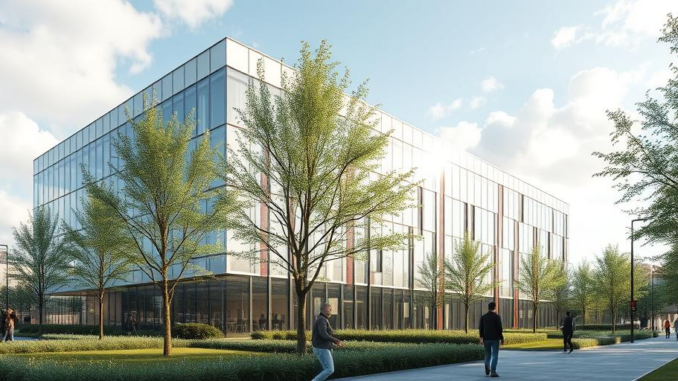
Summary
This article provides a practical, step-by-step guide for achieving BREEAM certification. It emphasizes the importance of early planning, collaboration with experts, and meticulous documentation. By following these actionable steps, projects can successfully meet BREEAM’s sustainability standards. The guide helps readers understand how to engage with BREEAM assessors effectively and prepare robust documentation.
Discover how Focus360 Energy can help with BREEAM certification.
** Main Story**
Okay, so navigating BREEAM certification…it can feel a bit like trying to find your way through a dense fog, right? But honestly, it doesn’t have to be that way. Think of this as your simplified roadmap. We’re breaking down the process into manageable steps, making that journey toward a sustainable building smoother and, well, less stressful.
Step 1: Early Engagement is Key
Seriously, just like you wouldn’t start a road trip without a map (or GPS, these days), don’t dive into a project without considering BREEAM from the very beginning. Trust me, it pays off. Integrate those sustainability considerations right from the outset. It can save you from those costly retrofits later on and keeps your design aligned with your green goals.
- Engage a BREEAM Accredited Professional (AP) ASAP. Their expertise? Invaluable. They can help you understand the specific needs of your project and develop a plan to get you that BREEAM rating you’re aiming for. It’s like having a BREEAM whisperer on your side from day one.
Step 2: Setting Realistic Targets
Now, let’s talk goals. Before you even think about fully launching this BREEAM endeavour, figure out what you realistically want to achieve. What rating are you shooting for? Consider the type of building, its location, budget and those little constraints that always seem to pop up.
- Setting realistic goals is crucial, because it means your resources are used efficiently. You don’t want to overspend or over-engineer, do you? Review those BREEAM standards and guidance docs – they’re your best friend when figuring out what your building needs.
Step 3: Assembling the Right Crew
Here’s the thing, you can’t build a sustainable building alone. You need a dream team!
- Collaborate closely with architects, engineers, contractors, and anyone else involved in the project. Communication is absolutely key; everyone needs to be on the same page when it comes to BREEAM requirements. Regular meetings? Essential. Open communication channels? Even more so!
Step 4: Mastering the Documentation
Alright, this part isn’t the most glamorous, but it’s vital: documentation.
- Keep detailed records throughout the project, documenting everything that relates to the assessment criteria. Energy performance data, materials specs, waste management plans, you name it.
Create a clear, organized system for managing all those documents. Use checklists and templates provided by BREEAM—they’re there for a reason! This will make the assessment process so much smoother. And, you know, provide valuable documentation for future reference.
- Pro tip: Present your evidence in a way that’s easy for the assessor to understand and verify. Clear summaries, cross-referencing documents, highlighting key sections – it all helps.
Step 5: Engaging with BREEAM Assessors
Think of your BREEAM assessor as your guide, not your adversary. They’re there to help you meet the standards, so engage with them early and keep the lines of communication open.
- Their guidance is essential for making sure your project meets the requirements. Schedule regular check-ins to review progress and tackle any challenges together.
Step 6: Post-Assessment Review
Okay, you’ve gone through the assessment…now what? Don’t just file it away!
- Carefully review the feedback from the assessor. What areas need improvement? What changes can you implement? This review is not only crucial for achieving certification, but it’s also about maximizing the long-term sustainability of your building. It could save you money in the future.
So, by following these steps, you can definitely navigate the BREEAM certification process with confidence. You’ll not only get a shiny badge of sustainability for your building, but you’ll also be doing your part for a greener future. And I think, you know, that’s something worth striving for.


“BREEAM whisperer,” you say? So, if my building could talk, it would be fluent in sustainable jargon and demand solar panels with a tiny carbon footprint? I’m picturing tiny green hardhats.
Ha! Love the image of tiny green hardhats. Maybe we need to start a line of BREEAM-themed building accessories! Seriously though, the goal is for buildings to ‘speak’ sustainability through design, materials, and operation. Solar panels with a tiny footprint are definitely part of the conversation!
Editor: FocusNews.Uk
Thank you to our Sponsor Focus 360 Energy
The emphasis on early engagement with a BREEAM AP is spot on. Their expertise in tailoring the BREEAM strategy to specific project needs can be invaluable. How have you seen early engagement with BREEAM APs affect project outcomes and overall sustainability performance?
Great point! Early BREEAM AP engagement allows for proactive problem-solving, preventing costly redesigns. We’ve seen projects where early AP involvement led to significant improvements in material selection and energy efficiency, ultimately boosting the building’s sustainability score and reducing its environmental impact. What are your experiences?
Editor: FocusNews.Uk
Thank you to our Sponsor Focus 360 Energy
The point about clear documentation is critical. Maintaining organized records not only aids the assessment process, but also provides a valuable resource for future building performance analysis and potential improvements. How do you integrate documentation into the building’s ongoing operational lifecycle?